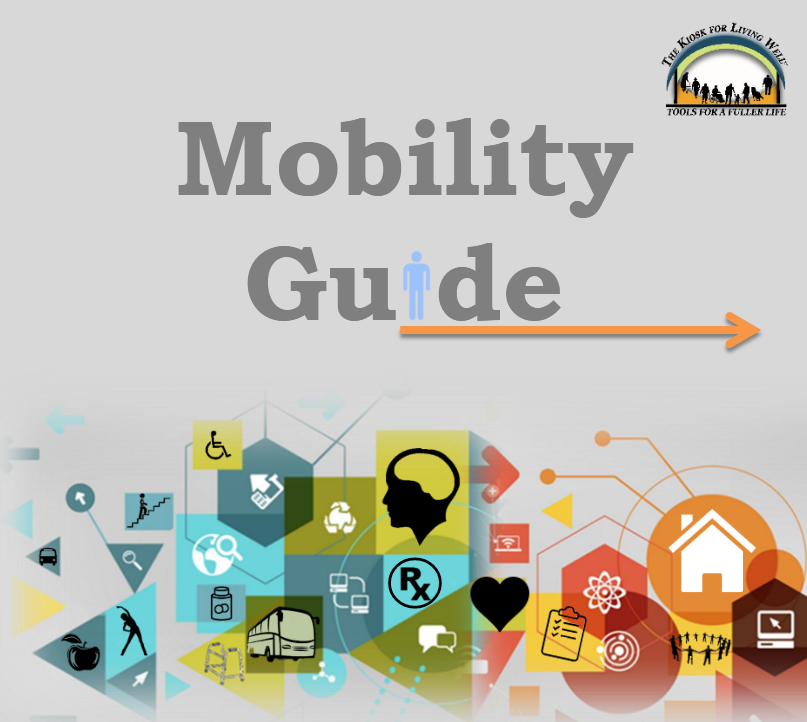Thank you to guest blogger Valerie Parker Callahan of Greater Lynn (MA) Senior Services for preparing this post. This article provides an overview of the Mobility Resource Guide, a reference tool that promotes unique approaches to mobility and accessibility.
“Mobility”—or the capacity to move freely and easily – is central to our fundamental concepts of freedom and independence. But, of course, mobility in terms of navigating home and community is not guaranteed. Over 3 million Americans with travel-limiting disabilities do not leave their homes due to a variety of challenges, at least some of which can – with proper focus and supports – be reduced. And one of the keys to reducing and ultimately eliminating mobility barriers is to think about mobility both from the perspective of the individual as well as the community. What can be done to strengthen a person’s capacity to move safely in terms of his or her balance, coordination, general energy reserves, wayfinding abilities, and overall confidence? What can be done to make the places in the community to which individuals wish to travel more inclusive and accessible?
Thinking about mobility from this dual perspective, Greater Lynn Senior Services, Inc. developed the Mobility Resource Guide.
What is the Mobility Resource Guide?
The Mobility Resource Guide project is based on the fundamental framework of finding, enhancing, and sustaining a “good fit” between each individual and the community in which he or she lives. The focus is on helping the individual at the micro-level to strengthen mobility capacities while at the macro-level, identifying the kinds of support in the physical environment that make the community more accessible, navigable, connected, inclusive and livable for everyone. Funded through a Massachusetts Department of Transportation grant, the project looks at mobility from a holistic perspective. The Guide identifies many of the dimensions and elements involved at both the individual and environmental level that determine who has the capacity to move freely from place to place, as well as how that capacity is realized.
A Holistic Approach to Mobility and Accessibility
The Guide synthesizes and documents state-of-the-art research in this emerging field into a simple and usable compact handbook that identifies a wide range of mobility challenges:
- lack of appropriate transportation
- assistive devices
- safe pathways
- illness
- disabilities
The Guide also addresses nutrition, depression, anxiety, fear of falling and medication regimens which can often times be overlooked, but are equally critical to mobility. In the first part of the Guide, challenges and subsequent recommendations and strategies for managing them are framed from the perspective of ways to strengthen the individual’s capacity. In its second part, the Guide looks through the lens of home environment and its physical structure to re-frame challenges and strategies. The lens broadens in the final part to focus on how all this plays out in the community.
The Guide is very much a problem-solving tool rather than a compendium of solutions.
It is designed to help readers define their mobility challenges in terms that are concrete, actionable, and manageable. In its pilot distribution, consumers and providers alike have told us they like the Guide’s framework and find it easy to follow. Some individuals have told us they particularly appreciate the opportunity to examine mobility barriers from different perspectives and to compare how and if strategies for resolving these can be integrated across the three dimensions of individual, home, and community. Others have said they appreciate the clarity of a “single focus at a time” approach and the “snap shot” presentations that get the main ideas across quickly. Readers also indicated that the diverse and comprehensive references have been especially helpful in finding great resources for learning more about specific topics.
The future of the Mobility Resource Guide
“But you’re thinking that someday we will develop something web-based?” Jim asked.
“Yes, I am hoping we can do just that at some point in the not too distant future, particularly after we learn more about how folks want to ‘interact’ with the Guide and its information.”
We hope to disseminate the Guide through multiple venues and are hoping to capture the feedback we need for the next iteration – a version that harnesses appropriate technology to meet many different consumer preferences and interests. But we’re still betting – or at least some of us who are a bit older are still betting – that the quiet, unassuming printed format will still make its mark.
The Mobility Resource Guide was developed and published by Greater Lynn Senior Services, Inc., located in Lynn, MA. For more information, please contact Valerie Parker Callahan, vparkercallahan@glss.net, or Aimee Garman, agarman@glss.net. Funding for the Guide was provided through a grant from the Massachusetts Department of Transportation.

Leave a Reply